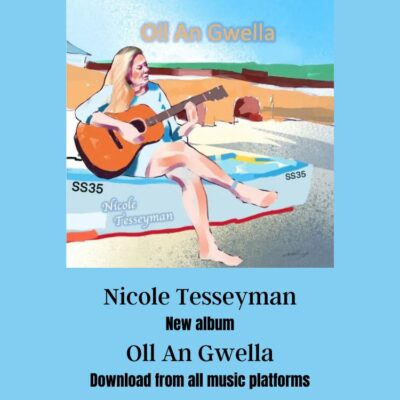In this, its centenary year, St Ives Old Cornwall Society celebrated members’ evening by replicating the format of the original meetings.
Trelawny was sung, after which artefacts, paintings, songs, information, drama, and memories of growing up in St Ives were interspersed with readings from the original log books and records kept by the society, which was founded by Robert Morton Nance and Henry Jenner in 1920.

Dave and Dee on song
Their remit was to record, remember, and celebrate the history of life in St Ives, and, by setting up other Old Cornwall Societies, spread their thoughts and ideas throughout Cornwall. They aimed to “Gather ye the fragments that are left, that nothing be lost”. This aim was very successful, as the group proved at its January meeting.
Paul Turner talked about living at 4 Fore Street, St Ives, as a child from 1938, and brought a painting he owns of the back yard to illustrate his talk. Doreen Barber talked about growing up in Halsetown, Sylvia Rule gave an illustrated talk on her life in St Erth, and Linda Peters explained, with original images from as early as 1905, her family’s ownership of their cottage at the top of Steeple Lane for more than 100 years.
Margaret Stevens showed members the Joannie (an original carved wooden doll) she inherited from her mother, and another doll she has owned since childhood, and Stuart Guppy read extracts from an Old St Ives guide book he owns.

Frank Stevens talks on geology
Mary Quick performed a dialect story and poem she had written, while Marion Smith had found an original Cornish ‘Droll’ in a book she owns called Cledry Plays, written by Robert Morton Nance for the children of Nancledra School in 1920. The play is called Duffy and is based on the fairy tale of Rumplestiltskin. Morton Nance, who was a Grand Bard, incorporated Cornish dialect into the play to raise awareness among the young. Duffy was ably re-enacted by Dee and Dave Brotherton, and Ivor Frankell. Dee and Dave sang in both Cornish and English and Frank Stevens explained, with pyrotechnics and rock samples, the geology of our area, and why mining formed such a large part of the local economy.
All this was interspersed with members reading snippets from original records of meetings documented by the society, and Brian Stevens explaining the roll of R J Noall and Morton Nance in establishing the Old Cornwall movement.
This interesting evening was the result of many hours of organisation and research by Margaret and Brian Stevens, and thanks must go to them and all members of St Ives Old Cornwall Society who took part in making the evening the success it was.


